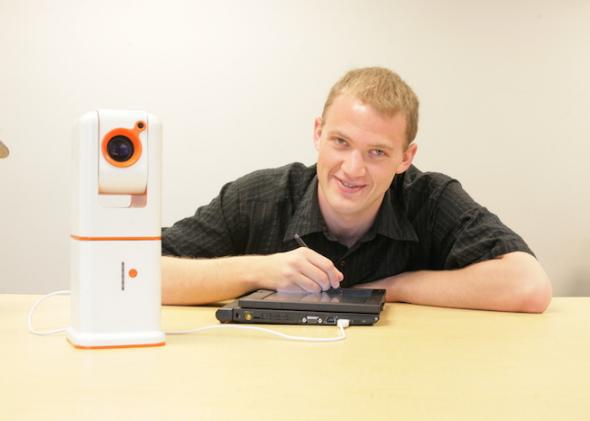This post is part of Future Tense, a collaboration among Arizona State University, New America, and Slate. At noon on Wednesday, March 4, Future Tense will host an event in Washington, D.C., on technology and the future of disability. For more information and to RSVP, visit the New America website.
Consider for a moment all of the visual cues you rely on when you walk into a room full of people. You can see how many people are there, where they are located, which directions they are facing, and whether they are moving.
You can also read the many nonverbal cues that add to what they are saying. Does a person smile with recognition when you walk in the room, or furrow their brow trying to remember who you are? Does your suggestion elicit a disapproving smirk or a nod of the head? Are your anecdotes met with rapt attention, or is the listener yawning and toying with their cellphone?
Sighted people take these cues for granted, interpreting this vast supply of information subconsciously. For people who are blind or visually impaired, the absence of this information can make social interactions extremely difficult and/or awkward. Fortunately, we can now develop technologies that provide the information in nonvisual ways.
Technology—particularly multimedia and ubiquitous computing—can help enrich life, enhance productivity and promote independent living for people across the entire spectrum of abilities. For example, the Center for Cognitive Ubiquitous Computing (CUbiC) at Arizona State University is developing a social interaction assistant to address the problems listed above for people with visual impairments. (Disclosure: I work for ASU; ASU is a partner with Slate and New America in Future Tense.)
One thing we have learned from working with potential users is that people with visual impairments rely heavily on their sense of hearing. If an assistive device provides auditory feedback, it could drown out important situational information. In the case of missed conversation, this would be inconvenient. In a situation like a traffic crossing, it would be hazardous. As a result, we are developing a wearable device that uses tactile cues such as pattern of vibrations to convey information.
Truly revolutionary technologies require engagement with users throughout the design and development process. While it’s helpful to get feedback and ideas from focus groups on users’ needs, short sessions don’t give us a full understanding of the challenges and opportunities in developing assistive technology solutions. It is imperative that people with disabilities play a leading role in envisioning, conceptualizing, developing, implementing, deploying, testing, and validating potential solutions, tools, and technologies.
Several years ago, an ASU student came to me asking about technology that might help him get access to the content of the blackboard in his classes. David Hayden was a freshman double-majoring in math and computer science, and he also was visually impaired. Even sitting at the front of the class couldn’t get him the access to the board to understand the process being enumerated in solving math problems or designing an algorithm by his professors.
I encouraged him to come work in my lab with a team to see how we could solve this problem. After all, who better understood this problem than David?
In his sophomore year, he began working at the CUbiC lab, developing an application on a tablet connected to a camera with a pan-tilt-zoom feature. He could take the device to his classes and have the video of the blackboard piped into his laptop. Then he did something even more clever—he split the screen into two halves. One side of the screen showed the video of the blackboard while the other was used to design a “notes” interface. He linked sections of the class notes to individual frames from the video.
David took the prototype to the classroom and shared it with other visually impaired students for obtaining their feedback, which he then used to further improve the device. At the end of his junior year, he submitted his invention to the worldwide Microsoft Imagine Cup competition in the “touch and tablet” category. He won both the national and world competitions in that category.
After graduation, David received an internship opportunity at NASA and is now pursuing a Ph.D. at MIT. He’s also manufacturing his Note-Taker prototype for use by others.
Once visually impaired students started using Note-Taker in classrooms, something truly remarkable happened. Sighted students began asking for the technology for their own use. This is not actually uncommon among well-designed assistive devices. For example, the first commercially successful typewriter, the Hansen Writing Ball, was designed to help blind people write through touch-typing. The QWERTY keyboards we use with our computers today are descendants of this accessibility tool.
In reality, we are all looking for ways to enhance our abilities. For instance, a soldier on the battlefield needs better access to information at night or in stressful environments. One could argue that blindness is not only a disability but a concept. We are all blind from a touch perspective to distant environments like exploring the surface of Mars. Assistive technologies have the power to transcend our limitations and enrich our lives.
